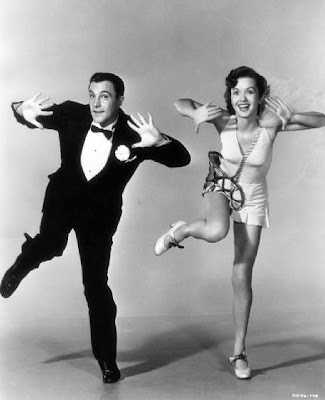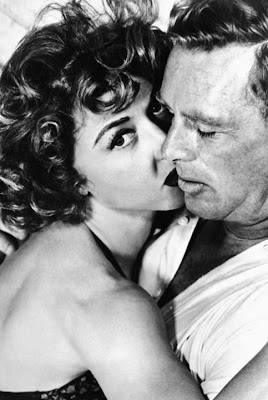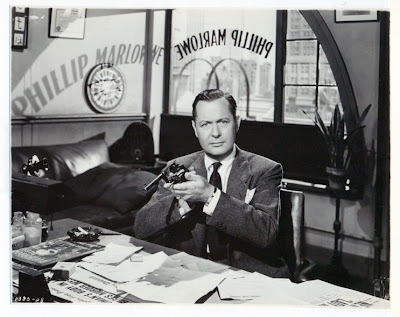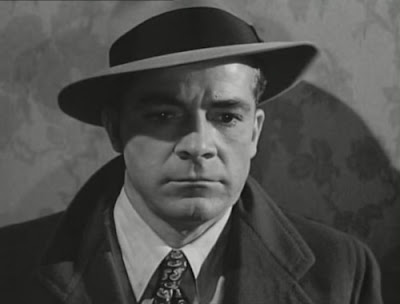 Gene Kelly and Debbie Reynolds in "Singin' in the Rain" (1952) directed by Stanley Donen & Gene Kelly
Gene Kelly and Debbie Reynolds in "Singin' in the Rain" (1952) directed by Stanley Donen & Gene KellyThis 60th anniversary presentation of the quintessential American musical includes a special interview with Debbie Reynolds conducted by TCM host Robert Osborne.
Thursday (7/12), 7pm
CINEMARK CEDAR PARK, 1335 E. Whitestone, Cedar Park
 See the "Singin' in the Rain 60th Anniversary" event at Quality 16 and Rave Motion Pictures. 2 and 7 p.m. $11.50. TCM host Robert Osborne interviews star Debbie Reynolds before the film. Tickets are available at participating theater box offices and online at www.FathomEvents.com. Q16 is at 3686 Jackson Road, Scio Township. 734-623-7469. Rave is at 4100 Carpenter Road, Pittsfield Township. 734-973-4823. Source: www.anarbor.com
See the "Singin' in the Rain 60th Anniversary" event at Quality 16 and Rave Motion Pictures. 2 and 7 p.m. $11.50. TCM host Robert Osborne interviews star Debbie Reynolds before the film. Tickets are available at participating theater box offices and online at www.FathomEvents.com. Q16 is at 3686 Jackson Road, Scio Township. 734-623-7469. Rave is at 4100 Carpenter Road, Pittsfield Township. 734-973-4823. Source: www.anarbor.com -Debbie Reynolds in interviews has said Gene was very demanding of her, especially since she wasn't a trained dancer. And Gene once said "I wasn't very nice to Debbie. I'm surprised she still speaks to me." Was that really the case?
-Debbie Reynolds in interviews has said Gene was very demanding of her, especially since she wasn't a trained dancer. And Gene once said "I wasn't very nice to Debbie. I'm surprised she still speaks to me." Was that really the case? -Another of the myths was that Gene didn't want her in the picture and he absolutely wanted her. It was actually [producer] Arthur Freed who brought Gene and [director] Stanley Donen up to the office and looked at "Abba Dabba Honeymoon," her number with Carleton Carpenter , and he thought she was the right one for that role and they agreed. Stanley asked, "Can she dance?" and she was not a trained dancer, but that didn't threaten Gene at all. Frank Sinatra was not a trained dancer, and he had taught so many young people how to dance, so he basically applied the same techniques. You hear Gene was a perfectionist, and he was absolutely demanding, but he demanded the same thing of everything and of himself. And I think trained dancers are used to that type of discipline.
-Another of the myths was that Gene didn't want her in the picture and he absolutely wanted her. It was actually [producer] Arthur Freed who brought Gene and [director] Stanley Donen up to the office and looked at "Abba Dabba Honeymoon," her number with Carleton Carpenter , and he thought she was the right one for that role and they agreed. Stanley asked, "Can she dance?" and she was not a trained dancer, but that didn't threaten Gene at all. Frank Sinatra was not a trained dancer, and he had taught so many young people how to dance, so he basically applied the same techniques. You hear Gene was a perfectionist, and he was absolutely demanding, but he demanded the same thing of everything and of himself. And I think trained dancers are used to that type of discipline. Debbie was transformed. I think [dance assistants] Carol Haney and Jeannie Coyne, working with her day in and day out in a lot of the rehearsals, helped her to advance. And Gene always said, "You choreograph to the woman," so he choreographed to Debbie's capabilities. You don't outchoreograph and outdance her, you make her look great. And it was the same thing with Sinatra, you choreograph to him. He choreographed to Olivia Newton-John in "Xanadu." You want your partner to look the best he or she can possibly look. And that was always his intent with Debbie, and she worked like a trouper and became a big star. Source: www.newsday.com
Debbie was transformed. I think [dance assistants] Carol Haney and Jeannie Coyne, working with her day in and day out in a lot of the rehearsals, helped her to advance. And Gene always said, "You choreograph to the woman," so he choreographed to Debbie's capabilities. You don't outchoreograph and outdance her, you make her look great. And it was the same thing with Sinatra, you choreograph to him. He choreographed to Olivia Newton-John in "Xanadu." You want your partner to look the best he or she can possibly look. And that was always his intent with Debbie, and she worked like a trouper and became a big star. Source: www.newsday.comClips from "Susan Slept Here" (1954) directed by Frank Tashlin, starring Dick Powell, Debbie Reynolds and Anne Francis
 "Susan Slept Here" is a glorious bath of Technicolor about a 35-year-old Oscar-winning screenwriter (played by Dick Powell) whose Christmas Eve includes a couple of cops delivering him a 17-year-old delinquent (Debbie Reynolds). She's the Susan of the title, she does indeed sleep there, and they even end up driving over to Las Vegas on Christmas day for an elopement.
"Susan Slept Here" is a glorious bath of Technicolor about a 35-year-old Oscar-winning screenwriter (played by Dick Powell) whose Christmas Eve includes a couple of cops delivering him a 17-year-old delinquent (Debbie Reynolds). She's the Susan of the title, she does indeed sleep there, and they even end up driving over to Las Vegas on Christmas day for an elopement.  It's almost curious that Hollywood in the 1950s is considered to have been a conservative period for the movies, yet here was director Frank Tashlin slyly making a film that repeatedly alludes to the idea of Powell, who was actually about 49 during filming what turned out to be his last movie, having sex with the underage Reynolds, who would have been 21 in real life.
It's almost curious that Hollywood in the 1950s is considered to have been a conservative period for the movies, yet here was director Frank Tashlin slyly making a film that repeatedly alludes to the idea of Powell, who was actually about 49 during filming what turned out to be his last movie, having sex with the underage Reynolds, who would have been 21 in real life.  Reynolds seems to transform from a cute kid to a rather alluring and even sexy young woman. Susan's choice of dress changes, as do parts of her personality. When she learns of the annulment and its basic conditions, her resolve is maybe more than a little shocking. Tashlin mixes this in as smoothly as possible and seems to trust his audience at all times. Source: film.thedigitalfix.com
Reynolds seems to transform from a cute kid to a rather alluring and even sexy young woman. Susan's choice of dress changes, as do parts of her personality. When she learns of the annulment and its basic conditions, her resolve is maybe more than a little shocking. Tashlin mixes this in as smoothly as possible and seems to trust his audience at all times. Source: film.thedigitalfix.com For instance, when Susan notices a picture of Mark’s longtime lover, Isabella (Anne Francis), it leads to this hilarious exchange:
For instance, when Susan notices a picture of Mark’s longtime lover, Isabella (Anne Francis), it leads to this hilarious exchange:Susan: “You know, I’d like to get a dye job and a facial like her.”
Mark: “Isabella is a natural blond.”
Susan: “You sure?”
Mark: “We’re very good friends. [pause] She told me.”
 When I first heard this line, I practically gasped with laughter at the little hint of naughtiness in Powell’s delivery of that last line. The meaning he injects into that weighted pause is just one of the things that makes him a severely-underrated actor. Source: trueclassics.net
When I first heard this line, I practically gasped with laughter at the little hint of naughtiness in Powell’s delivery of that last line. The meaning he injects into that weighted pause is just one of the things that makes him a severely-underrated actor. Source: trueclassics.net "Blocked screenwriter Dick Powell finds himself cuffed to teenage spunkster Debbie Reynolds on Christmas Eve after the reformatory bobcat gets dragged in by a cop pal trying to help Powell get ideas for his upcoming juvenile delinquent opus.
"Blocked screenwriter Dick Powell finds himself cuffed to teenage spunkster Debbie Reynolds on Christmas Eve after the reformatory bobcat gets dragged in by a cop pal trying to help Powell get ideas for his upcoming juvenile delinquent opus.  This being a '50s comedy, there is no shortage of did-they-or-didn't-they innuendo inundating the other characters -- most notably socialite fiancée Anne Francis and attorney Les Tremayne, who's got Freudian knots of his own. This being a Frank Tashlin comedy, however, the leering is continually compounded by an obsession with the pitfalls of all-American success and a culture that, if pushed all the way, could lead to Weekend dismantling. Powell's soured-ingénue middle-age, just a step away from the cynical alcoholism of secretary and fellow aged '30s gold digger Glenda Farrell, gets a lift from Reynolds' corruptible/corrupting jailbait bounce, herself as much of a commodity as the fiancée he's forever avoiding." Source: www.cinepassion.org
This being a '50s comedy, there is no shortage of did-they-or-didn't-they innuendo inundating the other characters -- most notably socialite fiancée Anne Francis and attorney Les Tremayne, who's got Freudian knots of his own. This being a Frank Tashlin comedy, however, the leering is continually compounded by an obsession with the pitfalls of all-American success and a culture that, if pushed all the way, could lead to Weekend dismantling. Powell's soured-ingénue middle-age, just a step away from the cynical alcoholism of secretary and fellow aged '30s gold digger Glenda Farrell, gets a lift from Reynolds' corruptible/corrupting jailbait bounce, herself as much of a commodity as the fiancée he's forever avoiding." Source: www.cinepassion.org


























































